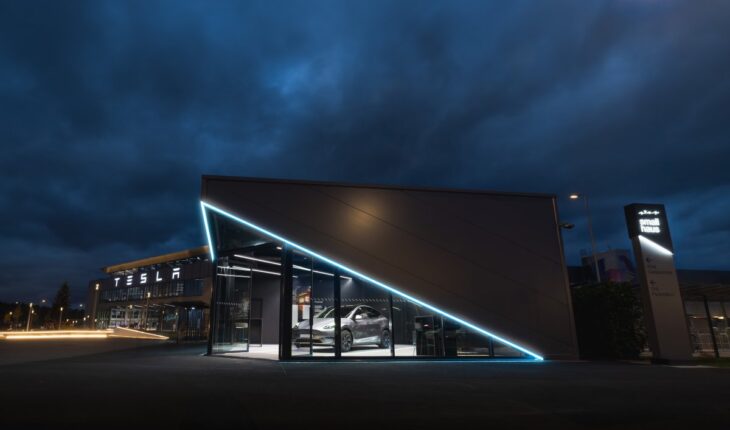By Karan Singh
Tesla recently showed off Giga Small Haus, an interesting new display project hosted at Giga Berlin. The small new house is located just outside the main entrance of Tesla’s Giga Berlin factory, with a Quicksilver Model Y parked inside.
Giga Small Haus is powered only by solar and Powerwall 3 – disconnected from the local grid and from Giga Berlin itself. It serves as a live demonstration of Tesla Solar and Tesla’s Powerwall battery backup.
Giga Small Haus
The centerpiece of the display is a Model Y in Quicksilver – a beautiful pick for a beautifully lit house. However, that’s not the real focus here – it’s the Powerwall and Gateway on the wall.
The Powerwall is the focus of Giga Small Haus, and there’s a display with some additional information on the wall. Part of the display also includes a screen that displays the current output of the Powerwall itself versus the consumption of Giga Small Haus, as well as the input from solar.
The text on the exhibit is divided into several sections. Here’s a translated and edited version of what we can see from Tesla’s images. Some additional text is obscured. If someone visits Giga Small Haus, let us know.
Powerwall
Powerwall is a home battery system that stores energy from solar panels, the electrical grid, or during off-peak hours and powers your home during the day or during a power outage.
With Powerwall, you can use self-generated solar energy during the day and night, thus avoiding high electricity costs. You can also store excess energy produced during sunny periods for use during times of low production or power outages.
Key Features
Energy Storage: Powerwall stores excess energy from solar panels or the grid for later use or during power outages.
Backup Power: In the event of a power outage, Powerwall automatically switches to battery power to ensure continuous power supply.
Integration: Powerwall can be seamlessly integrated with existing solar systems and other power sources.
Scalability: Multiple Powerwalls can be installed to meet higher energy storage needs.
Smart Energy Management: Powerwall works with Tesla’s software to optimize energy consumption and reduce costs.
How Powerwall Works
Storage: During the day, when solar panels produce more energy than needed, the excess is stored in Powerwall.
Usage: At night or during times of low solar production, the stored energy is used to power the home, reducing reliance on the grid.
Backup: During a power outage, Powerwall automatically provides power to critical circuits, ensuring continuous operation of essential appliances.
Benefits
Cost Savings: By storing and using solar energy, you can reduce your electricity bills.
Reliability: Provides backup power during outages, ensuring your home remains powered.
Sustainability: Promotes the use of renewable energy by storing excess solar production for later use.
Overall, Giga Small Haus is an interesting real-life demo of what Powerwall and Solar can accomplish. It would be neat if Tesla built more of these displays – perhaps near major Delivery and Service Centers and at Giga Texas, Fremont, Giga Shanghai, and other facilities. Many Tesla owners have yet to learn about and experience some of Tesla’s Energy products.
By Karan Singh
Tesla has added the Acceleration Boost option to the Tesla store for owners of the 2024 Model 3 Long Range – specifically owners in Australia and China. Acceleration Boost is an upgrade that provides a significant performance boost, drastically narrowing the performance gap between the Long Range and Performance versions of the same model.
This upgrade will likely become available in Europe, Canada, and the United States in the next few days as Tesla updates its shops globally.
Acceleration Boost
This new Acceleration Boost is retailing for $3,000 AUD, or approximately $2,000 USD. That’s the same price for current owners of older Model 3 or Model Y Long Range vehicles, which all have the option to purchase Acceleration Boost through the shop.
The boost provides improved 0-100km/h (0-60mph) performance, bumping the 2024 Model 3 LR from 4.4s to 3.8s. The 2024 Performance version comes in at a blazing fast 2.9 seconds, so while it isn’t equivalent to just buying a performance variant in the first place, it is still a noticeable and significant upgrade.
Performance variants also come with a different front fascia vent for cooling, performance drive units, sport seats, adaptive suspension, 20-inch wheels, and Track Mode V3. That’s a significant number of additional features in the $10,000 USD price difference between the Long Range and Performance versions.
Should You Buy It?
If you’ve purchased a Long Range model and are itching to go just that little bit faster at every red light, this is the upgrade for you. It previously came with the cost of slightly reducing vehicle range, but the Tesla store doesn’t make a note of reduced range this time around. The 2023 Model 3 and Model Y Long Range models had an efficiency loss of about 5% due to the additional always-available acceleration and cooling.
You could drive in Chill mode to mostly negate that efficiency loss, but what’s the fun in driving in Chill when you just got Acceleration Boost? Anyhow, the shop listing for the 2024 variant doesn’t include this detail, so it’s possible Tesla may have worked some more engineering magic.
Overall, if you’ve got the $3,000 AUD burning a hole in your pocket, some Tesla referral credits sitting around, or just want to go faster, it’s definitely an upgrade many users find valuable.
By Karan Singh
As December approaches, Tesla’s highly anticipated Holiday update draws closer. Each year, this eagerly awaited software release transforms Tesla vehicles with new features and festive flair. If you’re not familiar with Tesla’s holiday updates, take a look at what Tesla has launched in the Holiday update the past few years.
While leaked features like Blind Spot Monitoring While Parked hint at thoughtful improvements, the real magic lies in the unexpected. From potential features such as the Apple Watch app to a smart assistant, the possibilities are endless.
For this chapter in our series, we’re dreaming up ways Tesla could improve the charging experience and even add some additional safety features. So let’s take a look.
Destination State of Charge
Today, navigating to a destination is pretty straightforward on your Tesla. Your vehicle will automatically let you know when and where to charge, as well as for how long. However, you’ll likely arrive at your destination at a low state of charge.
Being able to set your destination state of charge would be an absolute game-changer for ease of road-tripping. After all, the best EV to road trip in is a Tesla due to the Supercharger network. It looks like Tesla may be listening. Last week, Tesla updated their app and hinted at such a feature coming to the Tesla app. A Christmas present, maybe?
Battery Precondition Options
While Tesla automatically preconditions your battery when needed for fast charging, there are various situations where manually preconditioning the battery would be beneficial.
Currently, there is no way to precondition for third-party chargers unless you “navigate” to a nearby Supercharger. If you need to navigate to a Supercharger that’s close by, the short distance between your location and the Supercharger will also not allow enough time to warm up the battery, causing slower charging times.
In Europe, you can navigate to and precondition for Qualified Third Party Chargers, but not for unlabelled ones.
Live Activities
While we already mentioned Live Activities in the Tesla app wishlist, they’d be especially useful while Supercharging. Live Activities are useful for short-term information you want to monitor, especially if it changes often — which makes them perfect for Supercharging, especially if you want to avoid idle fees.
Vehicle-to-Load / Vehicle-to-Home Functionality
The Cybertruck introduced Tesla Power Share, Tesla’s name for Vehicle-to-Home functionality (V2H). V2H allows an EV to supply power directly to a home. By leveraging the vehicle’s battery, V2H can provide backup power during outages and reduce energy costs by using stored energy during peak rates.
Tesla Power Share integrates seamlessly with Tesla Energy products and the Tesla app. We’d love to see this functionality across the entire Tesla lineup. Recently a third party demonstrated that bidirectional charging does work on current Tesla vehicles – namely on a 2022 Model Y.
Adaptive Headlights for North America
While Europe and China have had access to the Adaptive Headlights since earlier this year, North America is still waiting. The good news is that Lars Moravy, VP of Vehicle Engineering, said that these are on their way soon.
Blind Spot Indication with Ambient Lighting
Both the 2024 Highland Model 3 Refresh and the Cybertruck already have ambient lighting features, but they don’t currently offer a practical purpose besides some eye candy. So why not integrate that ambient lighting into the Blindspot Warning system so that the left or right side of the vehicle lights up when there’s a vehicle in your blind spot? Currently, only a simple red dot lights up in the front speaker grill, and the on-screen camera will also appear with a red border when signaling.
Having the ambient lighting change colors when a vehicle is in your blind spot would be a cool use of the technology, especially since the Model Y Juniper Refresh and Models S and X are supposed to get ambient lighting as well.
Tesla’s Holiday update is expected to arrive with update 2024.44.25 in just a few short weeks. We’ll have extensive coverage of its features when it finally arrives, but in the meantime, be sure to check out our other wishlist articles:


